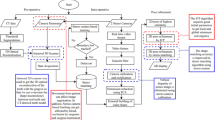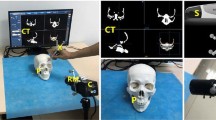Abstract
Purpose
Augmented reality-based constructive jaw surgery has been facing various limitations such as noise in real-time images, the navigational error of implants and jaw, image overlay error, and occlusion handling which have limited the implementation of augmented reality (AR) in corrective jaw surgery. This research aimed to improve the navigational accuracy, through noise and occlusion removal, during positioning of an implant in relation to the jaw bone to be cut or drilled.
Method
The proposed system consists of a weighting-based de-noising filter and depth mapping-based occlusion removal for removing any occluded object such as surgical tools, the surgeon’s body parts, and blood.
Results
The maxillary (upper jaw) and mandibular (lower jaw) jaw bone sample results show that the proposed method can achieve the image overlay error (video accuracy) of 0.23~0.35 mm and processing time of 8–12 frames per second compared to 0.35~0.45 mm and 6–11 frames per second by the existing best system.
Conclusion
The proposed system concentrates on removing the noise from the real-time video frame and the occlusion. Thus, the acceptable range of accuracy and the processing time are provided by this study for surgeons for carrying out a smooth surgical flow.











Similar content being viewed by others
References
Wang J, Suenaga H, Hoshi K, Yang L, Kobayashi E, Sakuma I, Liao H (2014) Augmented reality navigation with automatic marker-free image registration using 3-D image overlay for dental surgery. IEEE Trans Biomed Eng 61(4):1295–1304
Bruellmann D, Tjaden H, Schwanecke U, Barth P (2012) An optimized video system for augmented reality in endodontics: a feasibility study. Clin Oral Investig 17(2):441–448
Murugesan Y, Alsadoon A, Paul M, Prasad P (2018) A novel rotational matrix and translation vector (RMaTV) algorithms: geometric accuracy for augmented reality (AR) in oral and maxillofacial surgeries. Int J Med Rob Comput Assisted Surg 14:e1889. https://doi.org/10.1002/rcs.1889
Suenaga H, Tran H, Liao H, Masamune K, Dohi T, Hoshi K, Takato T (2015) Vision-based markerless registration using stereo vision and an augmented reality surgical navigation system: a pilot study. BMC Med Imaging 15(1):51. https://doi.org/10.1186/s12880-015-0089-5
Sielhorst T, Feuerstein M, Navab N (2008) Advanced medical displays: a literature review of augmented reality. J Disp Technol 4(4):451–467. https://doi.org/10.1109/jdt.2008.2001575
Wang J, Suenaga H, Liao H, Hoshi K, Yang L, Kobayashi E, Sakuma I (2015) Real-time computer-generated integral imaging and 3D image calibration for augmented reality surgical navigation. Comput Med Imaging Graph 40:147–159. https://doi.org/10.1016/j.compmedimag.2014.11.003
Kalal Z, Mikolajczyk K, Matas J (2012) Tracking-learning-detection. IEEE Trans Pattern Anal Mach Intell 34(7):1409–1422 https://doi.org/10.1109/tpami.2011.239
Choi H, Park Y, Lee S, Ha H, Kim S, Cho H, Hong J (2017) A portable surgical navigation device to display resection planes for bone tumor surgery. Minim Invasive Ther Allied Technol 26(3):144–150. https://doi.org/10.1080/13645706.2016.1274766
Wu J, Wang M, Liu K, Hu M, Lee P (2014) Real-time advanced spinal surgery via visible patient model and augmented reality system. Comput Methods Prog Biomed 113(3):869–881. https://doi.org/10.1016/j.cmpb.2013.12.021
Nakao M, Endo S, Nakao S, Yoshida M, Matsuda T (2016) Augmented endoscopic images overlaying shape changes in bone cutting procedures. PLoS One 11(9):e0161815. https://doi.org/10.1371/journal.pone.0161815
Chen X, Xu L, Wang Y, Wang H, Wang F, Zeng X, Wang Q, Egger J (2015) Development of a surgical navigation system based on augmented reality using an optical see-through head-mounted display. J Biomed Inform 55:124–131. https://doi.org/10.1016/j.jbi.2015.04.003
Hung K, Wang F, Wang H, Zhou W, Huang W, Wu Y (2017) Accuracy of a real-time surgical navigation system for the placement of quad zygomatic implants in the severe atrophic maxilla: a pilot clinical study. Clin Implant Dent Relat Res 19(3):458–465. https://doi.org/10.1111/cid.12475
Chen X, Xu L, Wang Y, Hao Y, Wang L (2016) Image-guided installation of 3D-printed patient-specific implant and its application in pelvic tumor resection and reconstruction surgery. Comput Methods Prog Biomed 125:66–78. https://doi.org/10.1016/j.cmpb.2015.10.020
Fitzpatrick J, West J, Maurer C (1998) Predicting error in rigid-body point-based registration. IEEE Trans Med Imaging 17(5):694–702. https://doi.org/10.1109/42.736021
Schicho K, Figl M, Seemann R, Donat M, Pretterklieber M, Birkfellner W et al (2007) Comparison of laser surface scanning and fiducial marker–based registration in frameless stereotaxy. J Neurosurg 106(4):704–709. https://doi.org/10.3171/jns.2007.106.4.704
Kilgus T, Heim E, Haase S, Prüfer S, Müller M, Seitel A, Fangerau M, Wiebe T, Iszatt J, Schlemmer HP, Hornegger J, Yen K, Maier-Hein L (2014) Mobile markerless augmented reality and its application in forensic medicine. Int J Comput Assist Radiol Surg 10(5):573–586. https://doi.org/10.1007/s11548-014-1106-9
Zinser M, Mischkowski R, Dreiseidler T, Thamm O, Rothamel D, Zöller J (2013) Computer-assisted orthognathic surgery: waferless maxillary positioning, versatility, and accuracy of an image-guided visualisation display. Br J Oral Maxillofac Surg 51(8):827–833. https://doi.org/10.1016/j.bjoms.2013.06.014
Wang J, Suenaga H, Yang L, Kobayashi E, Sakuma I (2016) Video see-through augmented reality for oral and maxillofacial surgery. Int J Med Rob Comput Assisted Surg 13(2):e1754 https://doi.org/10.1002/rcs.1754
Gold S, Rangarajan A, Lu C, Pappu S, Mjolsness E (1998) New algorithms for 2D and 3D point matching. Pattern Recogn 31(8):1019–1031. https://doi.org/10.1016/s0031-3203(98)80010-1
Ulrich M, Wiedemann C, Steger C (2012) Combining scale-space and similarity-based aspect graphs for fast 3D object recognition. IEEE Trans Pattern Anal Mach Intell 34(10):1902–1914. https://doi.org/10.1109/tpami.2011.266
Xiao J, Gerke M, Vosselman G (2012) Building extraction from oblique airborne imagery based on robust façade detection. ISPRS J Photogramm Remote Sens 68:65–68
Kalal Z, Mikolajczyk K, Matas J (2010) Forward-backward error: automatic detection of tracking failures. In: 2010 20Th international conference on pattern recognition. https://doi.org/10.1109/icpr.2010.675
Kazemi, M., Mohammadi, E., sadeghi, P., & Menhaj, M. (2017). A Non-local means approach for Gaussian noise removal from images using a modified weighting kernel. In Iranian Conference on Electr Eng Tehran: ICEE
He C., Liu Y. and Wang Y. Sensor-fusion based augmented-reality surgical navigation system. 2016. [Online]. Available: http://ieeexplore.ieee.org/document/7520404. Accessed 7 Jan 2018
Acknowledgements
This work was supported in part by Study Support Manager Angelika Maag from the Sydney Study Centre of Charles Sturt University, Sydney, Australia.
Author information
Authors and Affiliations
Corresponding author
Ethics declarations
Conflict of interest
The authors declare that they have no conflict of interest.
Ethical approval
Not Applicable.
Informed consent
Not Applicable.
Appendix
Appendix
Rights and permissions
About this article
Cite this article
Basnet, B.R., Alsadoon, A., Withana, C. et al. A novel noise filtered and occlusion removal: navigational accuracy in augmented reality-based constructive jaw surgery. Oral Maxillofac Surg 22, 385–401 (2018). https://doi.org/10.1007/s10006-018-0719-5
Received:
Accepted:
Published:
Issue Date:
DOI: https://doi.org/10.1007/s10006-018-0719-5




